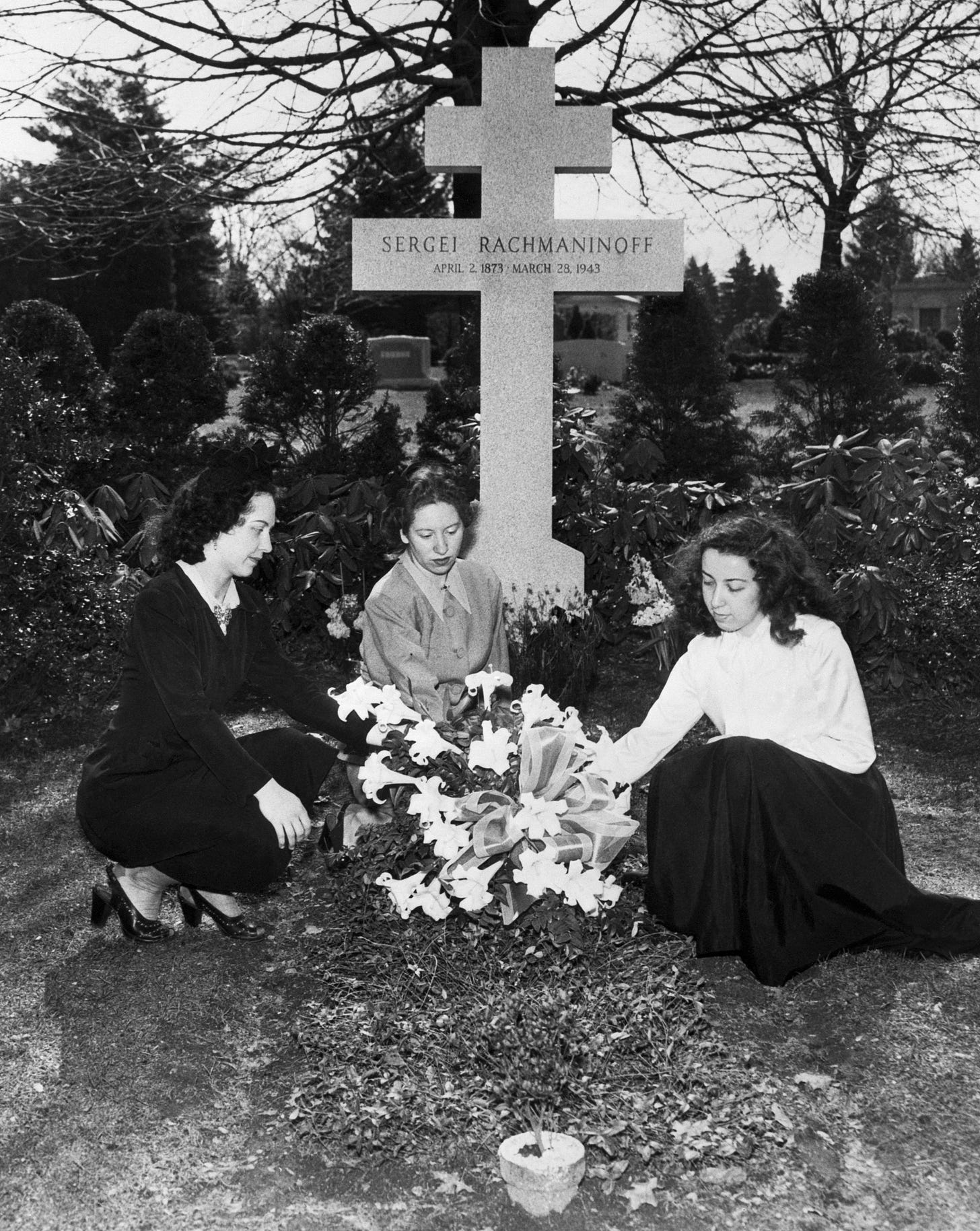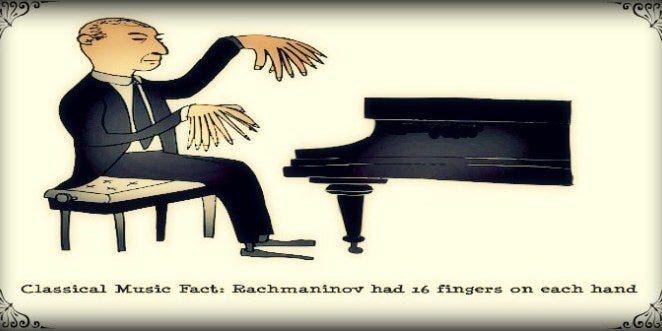Art Dogs is a weekly dispatch introducing the pets—dogs, yes!, but also cats, lizards, marmosets, and more—that were kept by our favorite artists. Subscribe to receive these weekly posts to your email inbox.
Sergei Rachmaninoff is one of the most famous composers, conductors, and pianists of the turn of the century, not just in Russia but in Europe and the United States. He performed more than 1,600 concerts over his lifetime, including more than 1,000 appearances in more than 200 cities in North America alone. He conducted operas and symphonic works on nearly 200 occasions.
He was remarkably gifted. He could recall whole symphonic movements decades after learning them. As an adult, he stood 6’6 and had “monster-sized” hands. It’s been reported that Rachmaninoff could cleanly strike a 13th. An above-average pianist’s hands can strike a 10th. (Watch this video to see what that means for a human hand on piano keys.) Put another way, Rachmaninoff had a hand span of at least 12 inches. The NBA has measured hand spans on their rookie basketball players for the past 24 years and only one basketball player has had a hand span of 12.0 inches….only eight have measured 11 inches or more.1
Before going any further, let’s listen to him. No written description can capture this.
Sergei’s talents were evident even at a young age. He was born in 1873 into a musical, aristocratic family that lived between St. Petersburg and Moscow. He began learning the piano at the age of four, and his mother noticed his talent quickly—Sergei could reproduce passages from memory without a wrong note.
Meanwhile, his father was losing all of the family’s money. He had to sell off five of their estates, and move his family to a small flat in Saint Petersburg. At age 10, Sergei enrolled at the Saint Petersburg Conservatory to study music. By the time he was 18, his father would abandon his family, and two sisters would die. Despite these hardships, he wrote his first huge hit at age 19—Prelude in C sharp minor.

At 24 years old, Sergei premiered his Symphony No. 1 in D Minor and it failed, affecting him deeply. “When the indescribable torture of this performance had at last come to an end, I was a different man,” Rachmaninoff told a biographer many years later. The failure triggered a psychological breakdown and sent Rachmaninoff into despair. In Moscow, Sergei would spend his days on the sofa, smoking cigarettes and drinking heavily, in apathy and isolation, reluctant to talk to anyone. He stopped composing for three years, became an insomniac, and lost his appetite. The only friend he felt he had at the time was a puppy named Levko, a leonberger who was given to him by T. S. Lyubatovich.
In an attempt to break this cycle, Sergei decided to spend a summer far from the capital. He went to stay with relatives in a village of Krasnenkoe (now Krasnoe) southwest of Moscow in hopes of having space to concentrate on his creative work. He arrived at the dacha with Levko, who was not yet a year old but was already so big he could scare people despite his peaceful and meek character.
By this time, Sergei felt so tormented that he began to have pain in his back, legs, and arms, so the days in Krasnenkoe were focused on how to improve his health and overcome his creative crisis. There were strict routines. By half past eight in the morning, everyone in the house would hear the sound of Sergei’s footsteps and the “soft paws of his dog in the corridor” on their way to daily, punctual breakfasts together, which a relative later described [translated from Russian]:
Sergei Vasilyevich, in high boots, in a light cotton shirt, and his important dog. “Levko, sit!” the composer would say, then he’d sit down at the table. Levko would walk away from the table and, bending his paws, dutifully take his perch in the far corner, twitching his ears while listening to the human voices, until the owner called: “Well Levko, it’s time to work.”2
Sergei spent those summer days reading, writing letters, and playing piano. (“Clear, hard sounds flew from Rachmaninoff's room: scales at different intervals, arpeggios, exercises, and so on, up to Chopin's etudes,” a relative recalled.) The heat that summer was exceptional, leaving the villagers in Krasnenkoe sleepy and Levko overheated. In a letter to a friend, the composer wrote about Levko in detail: “All day long he puffs like a steam engine, does not find a place for himself anywhere, sticks to me terribly.” As the evenings set in, Sergei would take Levko in a carriage to the Kalinovsky forest, and walk along the banks of the Khopra. Later at night, he would play short concerts for his family.
Sergei repeated these summer stays for three seasons, from 1899 to 1901. It took this time in the country with Levko, and visits to a hypnotherapist, Dr. Nikolai Dahl, to restore Sergei’s sanity and creativity. “At the beginning of the summer I could neither walk nor sit. I lay only and intensively treated. Now I am well. The pain almost left me,” Rachmaninov told a friend.
Sergei wrote the Piano Concerto No. 2, by all reports a triumph, between 1900-1901, much of it at the dacha in Krasnenkoe with Levko at his side. The piece experienced global success that would prove enduring. Sergei Prokofiev, a contemporary avant-garde composer, said the concerto was a work of "extraordinary," even "surprising" beauty. Nikolai Karlovich Medtner would later say these insightful words about the piece:
The theme of his most inspirational Second Concerto is not only the theme of his life, but invariably gives the impression of one of the most striking themes of Russia, and only because the soul of this theme is Russian. There is not a single ethnographic accessory here, not a sundress, not an armenian, not a single folk-song turnover, and meanwhile, every time from the very first bell strike you feel how Russia is rising to its full height.

Rachmaninoff’s career flourished thereafter. He married in 1902, became conductor of the Bolshoi Theatre from 1904–06, and relocated to Dresden, Germany, in 1906. He embarked upon his first tour of the United States as a pianist in 1909. After the Russian Revolution, Rachmaninoff and his family fled Russia permanently, settling in New York in 1918.
But before leaving the country he loved for good, he was able to spend a few more summers in the Russian countryside, this time with his wife and children and a new dog in tow.
Russia was Rachmaninoff’s muse, and moving away left a permanent scar. As he once wrote: “In losing my country, I lost myself also.”
That same scar is one that millions of Russians have acquired over the course of the last century, and continue to acquire today. The Second Concerto that Rachmaninoff created while living with Levko in the countryside remains a gift to many Russian emigrants. They can turn to the piece to remember and revisit the home that they left behind. “His music continues to nourish the nostalgia that so many many émigrés feel for their lost homeland, and for the values of a society and a culture that had been swept away by warfare and revolution.”3
Rachmaninoff knew that his lost nation and culture lived within his music. Thirty years into life as an exile, Rachmaninoff would tell a reporter “I am a Russian composer, and the land of my birth has influenced my temperament and outlook. My music is the product of my temperament, and so it is Russian music.” Though I’ve only been to Russia one time, even I can’t help but hear Rachmaninoff’s summers, melancholia and all, in this concerto. In an interview published posthumously in 1959, he reportedly claimed “I reflect the philosophy of old Russia…with its overtones of suffering and unrest, its pastoral but tragic beauty, its ancient and enduring glory.” Old Russia may have disappeared irrevocably, but Rachmaninoff’s music can offer us all a portal back to it, thus keeping the memory and imagination of the place he loved alive.
I wrote this post with the help of my dear friend
. One hundred years after Sergei Rachmaninoff and his family left Russia for the United States, Katya found herself doing the same. Katya shared Rachmaninoff’s music and story with me from her home in rainy San Francisco, as well as found and translated Russian language websites for me that contain obscure anecdotes about Rachmaninoff and Levko.Katya was raised in the late years of the Soviet Union in Yekaterinburg. As a little girl, she would go with her mother, who still teaches classical piano in Yekaterinburg, to hear the symphony play regularly, a tradition that she and her wife Anya keep alive today with visits to the San Francisco Symphony.
Though they lived in different eras, Katya told me that Rachmaninoff’s music, especially the Second Concerto, can still transport her home. When she listens to the piece, memories of long train rides through the countryside from Yekaterinburg to college in St. Petersburg come flooding back.
Rachmaninoff once said “music should bring relief. It should rehabilitate minds and souls.” It strikes me that those summers in the countryside with Levko brought Rachmaninoff the relief that his music offers others. His concertos help those who feel lost and severed from their identities remember who they are. Without knowing it, the friend that gave a young Sergei Rachmaninoff Levko, the family that housed him in the countryside, and the therapist that counseled him, gave a once-in-a-generation artist the opportunity to build a portal home—a masterful work of art that millions of other Russians could turn to to access a homeland they lost.
Sergei Rachmaninoff never got to see Russia again. He died in 1943 in his home in Beverly Hills, California. In his will, Rachmaninoff wished to be buried at Novodevichy Cemetery in Moscow, where Scriabin, Taneyev, and Chekhov were buried, but that was impossible.4

Instead, his body lies in a deserted cemetery one hour by train from New York City.5 His grave, marked by a simple Russian cross, stands on a quiet hillside next to his wife, Natalya Aleksandrovna, and daughter, Irina Volkonskaya.
A foreign landscape shelters him and his loved ones.
But the coffin in the ground is zinc, in case he can ever go home.6
Art Dogs is a weekly dispatch introducing the pets—dogs, yes!, but also cats, lizards, marmosets, and more—that were kept by our favorite artists. Subscribe to receive these weekly posts to your email inbox.
Shaquille O'Neal’s hands were not measured!
http://flibusta.site/b/384671/read
https://fishercenter.bard.edu/wp-content/uploads/2022/08/Rachmaninoff-Program.pdf
Wehrmeyer, Andreas (2004). Rakhmaninov. London: Haus Publishing. ISBN 978-1-904341-50-5
Get off the train at the “Valhalla” station!!!
http://flibusta.site/b/384671/read





![Sergei Rachmaninoff - [1926] Colorized : r/classicalmusic Sergei Rachmaninoff - [1926] Colorized : r/classicalmusic](https://substackcdn.com/image/fetch/$s_!3Vf1!,w_1456,c_limit,f_auto,q_auto:good,fl_progressive:steep/https%3A%2F%2Fsubstack-post-media.s3.amazonaws.com%2Fpublic%2Fimages%2F60a9a131-a6ba-4273-9013-8a572dc2e301_698x1024.jpeg)








Loved this post so so much. His music is a treasure. As a modestly capable pianist and a Russian language major who has been to St. Pete and Moscow several times (and once saw a performance of No 2 in St Pete), this brought back such tender feelings of adoration for everyone I knew and lived in Russia (all mid to late 90s). I too am VERY interested in a draw the dogs session.
I love this. If by chance, you have not seen “Brief Encounter,” you will love it. The Rach 2 is the music for the entire film.